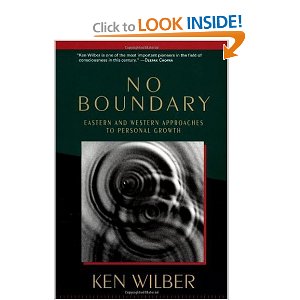
Ken Wilber
Editorial Reviews
“Ken Wilber is one of the most important pioneers in the field of consciousness in this century.”—Deepak Chopra
“The most sensible, comprehensive book on consciousness since William James.”—Dr. James Fadiman, President, Association for Transpersonal Psychology
“No Boundary does for this generation what Alan Watts' writings did for an earlier one. It brings the most difficult subject of all—nature of consciousness—into an easily grasped presentation that is both elegant and simple.”—John White, editor of Kundalini, Evolution, and Enlightenment
Product Description
A simple yet comprehensive guide to the types of psychologies and therapies available from Eastern and Western sources. Each chapter includes a specific exercise designed to help the reader understand the nature and practice of the specific therapies. Wilber presents an easy-to-use map of human consciousness against which the various therapies are introduced and explained. This edition includes a new preface.
Guest Review
4.0 out of 5 stars Transpersonal synthesis of psychology and spirituality, August 8, 2000
By Peter A. Kindle (Kansas City, Missouri)
Ken Wilber has provided a synthesis of virtually all psychological theories and spiritual perspectives in this short introduction to his spectrum of consciousness. Consciousness, in this context, refers to our personal sense of identify, our personal answer to the question,”Who am I?” Wilber makes much of the fact that our first answer to this question is largely a matter of identifying that which is “not me.” The distinction between “me” and “not me” is the fundamental human error, for in making it we deny our oneness with all reality. Hence the title indicates that to grow in consciousness is to eliminate these artificial boundaries. The first half of the book explains this in detail.
Fortunately, our denial of oneness with reality results in dissatisfaction with life that becomes the primary motivation to resolve four basic false dichotomies: (1) persona versus shadow; (2) ego versus body; (3) centaur versus environment; and (4) transpersonal identity versus unity consciousness. At each stage, the harmony in identity that follows elimination of the boundary becomes a new identity defined by new boundaries. Persona and shadow become ego. Ego and body become centaur. Centaur and environment become a transpersonal, but non-universal, identity. Only in unity consciousness, or oneness with all reality, do we eliminate boundaries and find peace.
Chapters are devoted to all four dichotomies. In each Wilber discusses the nature of the boundary conflict and therapeutic approaches sympathetic to its resolution. Interestingly, he understands the conflicts in various therapeutic approaches to be differences in dichotomy rather than truth. Some therapies work for one stage; others for another; all have value at times. Often he discusses the spiritual/religious impact of the dichotomies and their resolution. In each chapter he provides a narrative discussion of related materials by other authors for further study.
Everyone will not find Wilber totally convincing. Jungians will be disappointed in Wilber's simplistic resolution of the persona/shadow boundary. Christians will be uncomfortable with the strong Hindu emphasis in unity consciousness. Behaviorists will note their total absence in the discussion. Those predisposed to resist Wilber's synthesis should take note that it is not fair to reject Wilber without providing a equally sensitive and compelling synthesis of the myriad therapies, theories of personality and spiritualities that have lasting value worldwide.
This book is a primer, but one that awakened a desire in me to read more comprehensively and thoroughly. The analytical approach of experimental psychology is unlikely to answer the deepest questions of humanity. Wilber's spectrum provides a working model that may.




